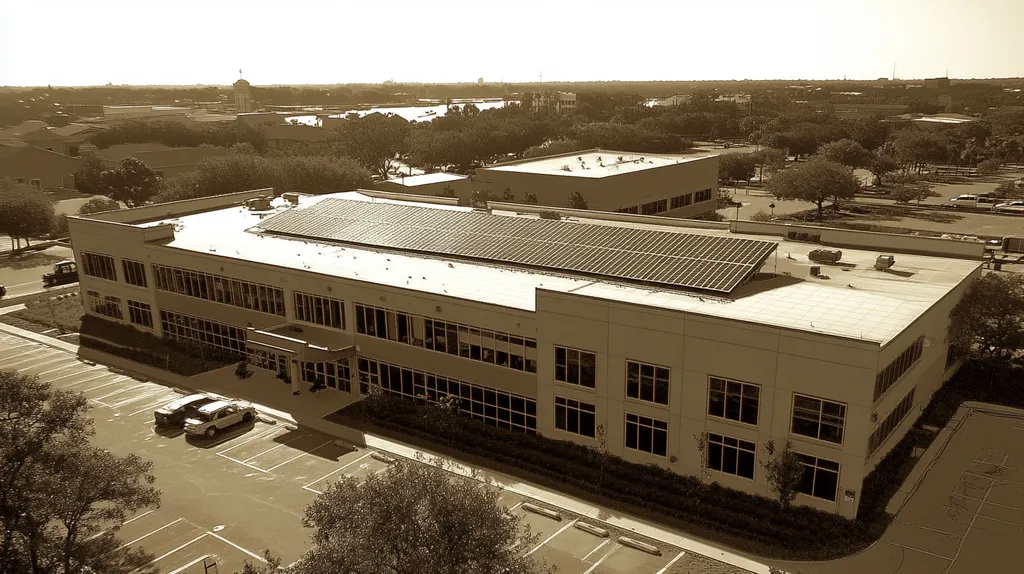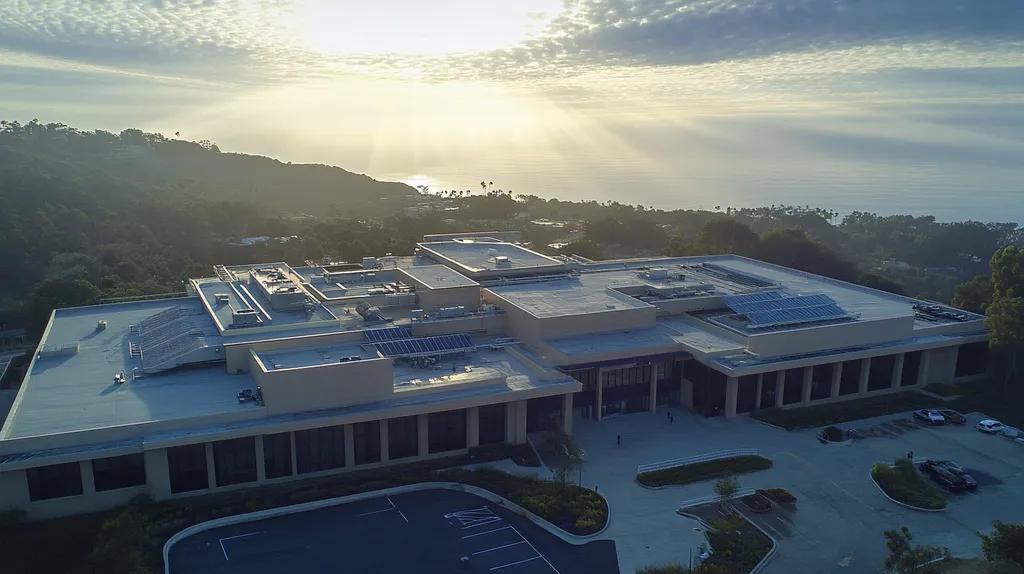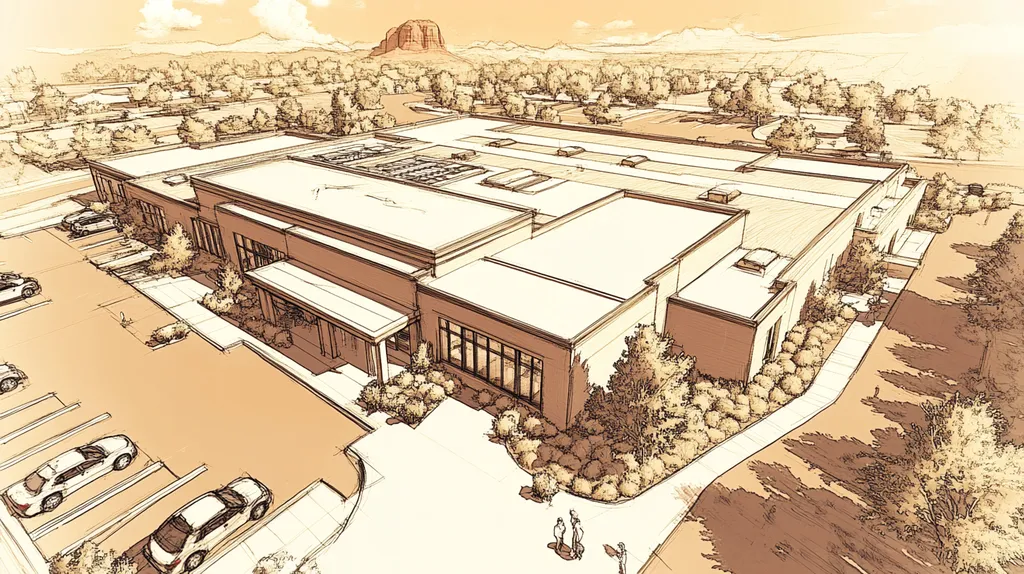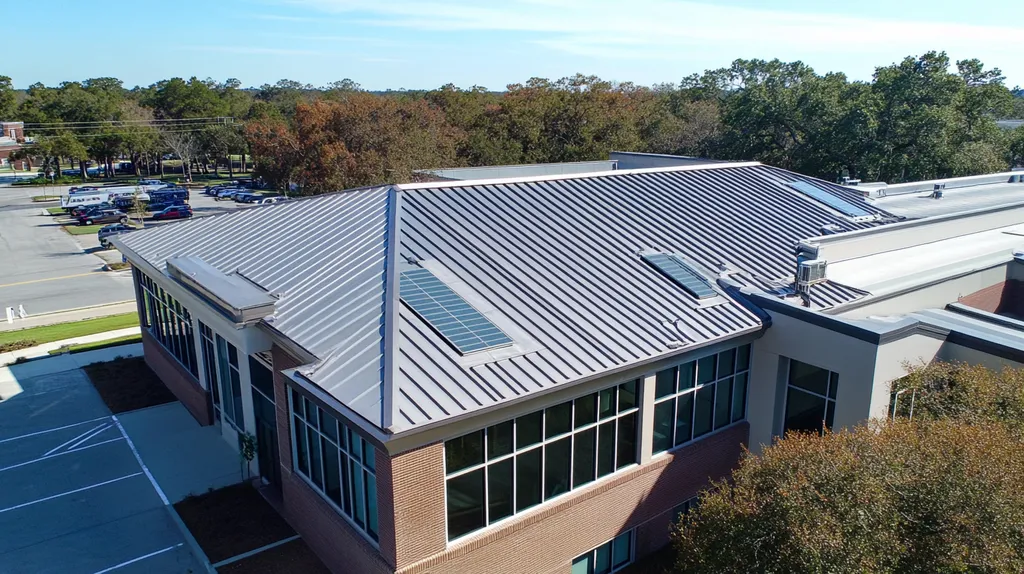With buildings responsible for nearly 40% of global carbon emissions, industrial roofs have emerged as unexpected heroes in the sustainability revolution. Yet most facility managers overlook their rooftops’ potential to slash energy costs by up to 30% while advancing environmental goals.
From cool roofing technology to integrated solar solutions, modern industrial roofs offer powerful tools for meeting corporate sustainability targets – when properly understood and implemented.
This guide cuts through the marketing hype to deliver practical insights on leveraging your industrial roof for meaningful environmental impact and operational savings.
SECTION 1: THE BASICS EXPLAINED
With buildings responsible for a whopping 39% of global carbon emissions, understanding how industrial roofs can play a pivotal role in sustainability is not just smart—it’s essential. An informed roofing choice doesn’t merely shelter a property; it can actively reduce environmental impact and save money. From slashing energy costs to boosting durability, modern roofing strategies are indispensable for any forward-thinking facility manager.
What It Is (In Plain Language)
So, what exactly is an industrial roof? Think of it as the crown of your commercial building, engineered to fend off nature’s wrath while keeping the structure intact. Typically flat or low-sloped, these roofs do much more than hold up the ceiling; they provide insulation, resist weather damage, and manage energy use effectively.
They come in various materials—metal, single-ply membranes, built-up systems—each with its own pros and cons when it comes to performance and longevity. Selecting the right roofing material is not just about style; it’s crucial for achieving sustainability goals.
Thanks to advancements in roofing tech, options like green roofs and solar energy systems are shaking things up. These solutions don’t just extend the life of the roof; they also align beautifully with environmental initiatives, allowing businesses to seamlessly integrate sustainability into their strategic goals.
In short, an industrial roof is far more than a protective shield; it’s a game-changer in a company’s commitment to sustainable practices.
Why It Matters (To Your Building)
The condition and design of an industrial roof can drastically affect a building’s performance and energy efficiency. An optimized roof can lead to significant savings on heating and cooling—general expenses that often weigh heavily on the budget. Conversely, a poorly designed roof can lead to leaks, inviting costly water damage and mold.
Investing in a top-notch roofing system isn’t just a nice-to-have; it’s a long-term strategy for both savings and sustainability. For instance, reflective roof coatings can dramatically reduce heat absorption, cutting down energy needs when temperatures soar. This smart move not only lowers utility bills but also lightens your carbon footprint.
Additionally, smart industrial roofs can be designed to capture and reuse rainwater, enhancing overall water management. By incorporating eco-friendly practices, organizations can showcase their commitment to broader corporate social responsibility initiatives.
Ultimately, the right roofing design doesn’t just shield from the elements; it actively drives a building’s energy efficiency and sustainability goals.
How It Works
Grasping how an industrial roof contributes to sustainability boils down to three primary roles: protection, energy efficiency, and resource management. First and foremost, roofing materials are essential for safeguarding the building’s interior from the outside elements, ensuring its longevity and performance.
Next up, energy-efficient roofing systems can dramatically lower energy consumption. For instance, cool roofs reflect more sunlight and absorb less heat, which cuts down on cooling needs. This clever technology maximizes energy efficiency and optimizes climate control.
Finally, roofs can be part of larger sustainability efforts through features like solar panels and green roofs. Solar systems harness sunlight to produce clean energy, helping achieve renewable energy targets. Meanwhile, green roofs provide insulation and absorb rainwater, reducing runoff and boosting biodiversity.
By focusing on these critical functions, property owners and facility managers can select roofing systems that align with their sustainability objectives—and ultimately reap significant long-term savings while making a positive impact on the environment.
SECTION 2: PRACTICAL APPLICATIONS
In an era where sustainability isn’t just a buzzword but a business imperative, industrial roofing emerges as a key player in helping companies achieve their environmental goals. The Energy Star program estimates that upgrading commercial roofs can slash energy costs by up to 20%. Not only do effective roofing solutions ensure compliance with regulations, but they also enhance property value, making it critical for property owners and facility managers to grasp these practical applications.
Common Uses & Examples
Industrial roofs are versatile champions of sustainability across various applications. For instance, cool roofing technology reflects sunlight, dramatically reducing heat absorption. A study from the Lawrence Berkeley National Laboratory shows that these roofs can lower rooftop temperatures by up to 60°F, leading to notable energy savings.
Another rising star is solar roofing, which seamlessly integrates photovoltaic panels into the roof system. This innovation enables facilities to generate their own renewable energy, cutting dependency on fossil fuels. Reports indicate that businesses with solar roofs enjoy utility cost reductions ranging from 30% to 50%—now that’s a win-win.
Let’s not forget green roofs, where nature meets architecture. These living roofs not only add visual appeal but also enhance insulation and aid in stormwater management. By absorbing rainwater, they contribute to local biodiversity and are especially beneficial in urban areas, making our cities a little greener.
When You Need It Most
Timing is everything when it comes to roofing upgrades. Property owners should seize the moment to enhance energy efficiency during new construction projects. By integrating sustainable roofing systems from the get-go, companies can sidestep costly retrofits down the line and hit the ground running.
If aging roofs are driving up energy costs, it’s high time for action. According to the U.S. Department of Energy, buildings with poor roofing can consume 2-3 times more energy than those with modern systems. Upgrading roofs isn’t just smart; it’s a necessity for both financial and environmental health.
Additionally, businesses situated in regions prone to severe weather should prioritize durable, sustainable roofing options. Investing in robust systems not only mitigates long-term repair costs but also aligns with broader sustainability goals. Delaying these upgrades can lead to ever-increasing maintenance expenses, putting the bottom line at risk.
Interactions With Other Systems
Industrial roofs don’t operate in isolation; they work hand in hand with various building systems to enhance overall efficiency. When integrated with HVAC systems, reflective roofs can substantially reduce cooling loads, leading to energy savings that can make the initial investment worth it.
Effective drainage systems are essential for managing roof runoff, minimizing flood risks, and preventing damage. Consider designing roofs to direct rainwater into barrels or cisterns—this eco-friendly approach not only conserves water but also improves local water quality.
Moreover, roofing systems can support broader green initiatives. For example, adding roof-mounted wind turbines could boost energy production and fulfill corporate sustainability commitments. The key lies in ensuring all these systems work together cohesively for maximum impact and efficiency.
SECTION 3: KEY TERMINOLOGY DECODED
Navigating the world of industrial roofing demands a solid grasp of essential terms. Misunderstanding common jargon can lead to costly mistakes and wasted resources. For example, not comprehending the environmental impact of different roofing materials can severely undermine a facility’s long-term sustainability goals. When property owners and facility managers equip themselves with precise language, they empower themselves to make smarter decisions that benefit both their bottom line and the planet.
Essential Terms Explained
Let’s kick things off with “cool roofing.” This term refers to roofing materials specifically designed to reflect sunlight and minimize heat absorption. Choosing cool roofing isn’t just a trendy upgrade; it can slash energy consumption, keeping buildings cooler and drastically lowering air conditioning costs.
Next up is the “green roof.” These roofs boast a lush covering of vegetation, offering insulation, improving air quality, and effectively managing stormwater. Green roofs play a crucial role in combating urban heat islands, making them a savvy investment for enhancing a building’s energy efficiency.
Then there’s the “R-value,” which measures thermal resistance. The higher this value, the better the material provides insulation. Selecting roofing with a high R-value can significantly decrease energy demands, translating into reduced utility bills and a lighter carbon footprint.
Lastly, “life cycle assessment” evaluates a roofing system’s environmental impact throughout its lifespan. This process guides property owners in selecting materials and maintenance strategies that align with their sustainability objectives, ensuring decisions aren’t just cost-effective but also environmentally sound.
Industry Jargon Translated
Industry jargon may create walls between technical specialists and property owners. For instance, “TPO,” or thermoplastic polyolefin, is a widely referenced roofing material known for its energy efficiency and cost-effectiveness. This makes TPO a favored choice for industrial facilities pursuing sustainability.
Another jargon term is “PVC,” which stands for polyvinyl chloride. PVC roofing systems are celebrated for their durability and resistance to environmental challenges, helping prolong a building’s life while contributing to sustainable efforts. Mastering this terminology is critical for all stakeholders aiming to meet their sustainability goals.
We can’t overlook “flashing,” which refers to the material that directs water away from crucial roof areas. Properly installed flashing can prevent leaks and prolonged water damage, ensuring that a roofing system remains both effective and sustainable.
Additionally, “thermal mass” describes how well a material can absorb and store heat. Opting for roofing materials with high thermal mass can significantly enhance energy efficiency, contributing to sustainable practices by helping maintain comfortable temperatures within buildings.
Measurement & Units Simplified
To effectively discuss roofing systems, it’s essential to understand various measurement units. Take the term “square,” which refers to a roofing area of 100 square feet. This straightforward unit aids property owners in calculating costs and determining material needs more accurately.
Another key measurement is the “mil,” indicating thickness. One mil equals one-thousandth of an inch and is particularly relevant in membrane roofing systems, as thickness impacts both durability and energy efficiency.
Water drainage is often expressed in “inches per hour,” reflecting how quickly water can flow off a roof. Understanding this measurement ensures that a roofing system effectively handles rainfall, preventing leaks and prolonging its lifespan.
Finally, we have the “wind uplift rating,” measured in pounds per square foot (psf). This rating indicates how well a roofing system can withstand wind forces. High ratings bolster a roof’s sustainability by minimizing the risk of damage, which cuts repair costs and reduces resource wastage.
SECTION 4: DECISION FACTORS
The process of choosing an industrial roof is no small feat, especially for those intent on hitting sustainability targets. With around 30% of a facility’s energy use linked to its roofing system, this decision holds weight. The right choice in materials and design not only bolsters environmental performance but can also lead to impressive cost savings. Here, we delve into critical decision factors: cost considerations, performance trade-offs, and the all-important durability.
Cost Considerations
When selecting an industrial roof, cost is often front and center. Sure, cheaper materials may seem appealing at first—who doesn’t love saving a buck? But those low initial costs often come with hidden fees and frequent repair bills down the line.
Opting for sustainable roofing solutions may seem like an upfront investment, but the long-term savings can be substantial. High-quality roofing materials tend to offer better insulation, which in turn slashes energy consumption and lowers those pesky utility bills.
Don’t sleep on potential incentives that can help ease the financial burden. Tax breaks for eco-friendly practices can help balance initial costs, making that green roof look a lot more appealing as a long-term investment.
In the end, a thorough review of both upfront and ongoing costs is crucial for making a savvy decision that aligns with sustainability goals.
Performance Trade-offs
Performance considerations are equally important in the roofing selection process. A roof must stand strong against the elements if it’s to play its role in sustainability. However, not all energy-efficient materials are created equal; some may crumble under extreme weather pressure, leading to a maintenance nightmare.
For example, while reflective materials can help lower heat absorption and energy use, their effectiveness might waver depending on the local climate. Selecting the right material means navigating these potential trade-offs and weighing immediate performance against long-term sustainability.
Understanding these nuances empowers facility managers to make informed choices that meet immediate needs while paving the way for sustainable success.
Lifespan & Durability Factors
The lifespan of a roofing system is a crucial component of any sustainability strategy. Choosing materials that last means less frequent replacements, translating to reduced waste and resource consumption. Sustainable roofing options often provide longer lifespans, aligning perfectly with eco-friendly goals.
Equally essential is durability. Roofing systems face the brunt of Mother Nature, so selecting robust materials can fend off leaks and installation errors, extending the roof’s life cycle.
Warranties and maintenance are part and parcel of durability considerations. A solid warranty equates to peace of mind, while low-maintenance materials help support sustainability initiatives.
Ultimately, investing in a long-lasting and resilient roof is a key factor for achieving sustainability goals while minimizing environmental footprints.
SECTION 5: COMMON CHALLENGES
In the race to meet sustainability objectives, industrial roofs often encounter substantial hurdles that can derail progress. A striking 30% of commercial buildings are plagued by roofing problems that lead to energy inefficiencies. Addressing these issues is critical for ensuring roofs not only shelter buildings but also actively contribute to sustainability goals. This section dives into common roofing challenges, warning signs to look out for, and proactive measures that can make a significant difference.
Frequent Problems & Solutions
When it comes to roofing, leaks, insufficient insulation, and membrane deterioration are among the usual suspects. Not only do these problems threaten the roof’s lifespan, but they can also add to energy inefficiencies. A single leak, for instance, can lead to extensive water damage, resulting in hefty repair bills and steeper energy costs.
Regular inspections and maintenance are vital solutions to these woes. Creating a robust inspection routine can catch minor issues before they snowball into major disasters. Roof coatings can extend the lifespan of a roof and bolster insulation, yielding significant energy savings in the process.
Modern materials like reflective membranes are game-changers in combating the heat island effect and enhancing sustainability. Plus, investing in quality installations reduces the likelihood of common issues cropping up, protecting valuable investments for the long haul.
By implementing these solutions, property owners can ensure their roofs do more than provide cover—they can actively support sustainability objectives while enhancing energy efficiency.
Warning Signs To Watch For
Property owners and facility managers must keep an eye out for specific warning signs that can point to roofing troubles. Stains on ceilings or walls are usually red flags indicating leaks, while standing water on the roof can signal drainage issues, setting the stage for membrane failures.
Look out for frayed or cracked roof membranes, signs that could jeopardize thermal performance. These visible signs of wear can escalate quickly, making proactive monitoring essential to avoid larger headaches down the road.
Sudden spikes in energy costs may indicate insulation failure or air leaks, further emphasizing the need for routine assessments. These warning signs often serve as early indicators of underlying problems that, if ignored, can complicate sustainability efforts.
Staying vigilant and responsive to these cues allows for timely repairs, helping to maintain both the roof’s integrity and the organization’s sustainability commitments.
Preventative Approaches
Preventative maintenance is crucial for effectively tackling roofing challenges. Regular inspections, paired with timely repairs, can mitigate many common issues before they escalate into costly failures. In fact, maintaining a steady inspection schedule can cut emergency repair costs by as much as 50%.
Utilizing technology like thermal imaging can identify hidden leaks and insulation flaws without invasive methods. This proactive strategy significantly amps up a building’s energy efficiency and performance.
Engaging certified roofing professionals ensures that the latest best practices are in play. They can offer tailored advice that takes into account the unique characteristics of the building and its environment.
By adopting these proactive measures, property owners can extend the life of their roofs while significantly contributing to their sustainability goals, paving the way for responsible building management.
SECTION 6: NEXT STEPS & RESOURCES
The pressure is on for businesses to meet sustainability goals, and industrial roofs are a critical part of that equation. Far too often, these roofs are treated as mere afterthoughts, missing out on their potential to drastically cut energy costs—by as much as 30%—and reduce environmental impact. This section breaks down crucial questions for roofing providers, highlights industry standards, and offers resources for ongoing learning.
Questions To Ask Providers
Property owners must take a hard look at roofing providers before signing on the dotted line. This isn’t just about picking any random contractor; it’s about aligning with a team that can help achieve sustainability goals. Start by asking which materials they use and whether these are eco-certified.
Next, probe into their experience with energy-efficient designs. It’s crucial to understand how the contractor incorporates sustainability into their projects. You wouldn’t hire a chef who only knows how to boil water, so don’t settle for a roofer who lacks a green game plan.
Dive deeper by inquiring about warranties and maintenance options too. A comprehensive maintenance plan can prolong the roof’s life expectancy and further push those sustainability buttons.
These questions equip property owners to make sound choices that align their roofing initiatives with broader sustainability efforts—because better roofs make for better businesses.
Industry Standards & Guidelines
When it comes to sustainability, sticking to established industry standards is non-negotiable. Organizations like ASTM and the Cool Roof Rating Council lay out essential guidelines for material performance and energy efficiency. Aligning roofing projects with these standards isn’t just smart; it boosts credibility in a competitive commercial landscape.
Moreover, understanding LEED certification requirements for roofing solutions can separate the wheat from the chaff when it comes to sustainable practices. Using these guidelines not only enhances a facility’s environmental reputation but positions it as a leader in an increasingly eco-conscious market.
Keep an eye on regular updates from these organizations. They often highlight new materials and technologies that can bolster sustainability efforts. Staying informed isn’t just beneficial; it’s vital for facility managers eager to play the long game in sustainability.
Compliance with these recognized guidelines can meet regulatory demands and establish a reputation as an industry frontrunner in sustainability.
Further Learning Simplified
Constant evolution is the name of the game in sustainable roofing, and continuous education is the ace up your sleeve. Numerous resources offer insights into cutting-edge practices and innovations. Online platforms and webinars hosted by industry experts can boost your knowledge base effectively.
Industry publications consistently release case studies and articles showcasing success stories in sustainable roofing. Tapping into these resources can not only inspire but also provide actionable insights for practical implementation.
Networking within professional circles is another gem. Engaging with peers through industry organizations fosters a rich exchange of ideas, keeping everyone at the forefront of innovation.
By committing to ongoing education, facility managers and property owners ensure they make informed decisions that align with both their roofing projects and sustainability aspirations. Remember, staying educated is part of staying relevant in the fast-evolving world of industrial roofing.
The Bottom Line
With industrial roofs accounting for up to 30% of a facility’s energy consumption, the stakes for sustainability couldn’t be higher.
Modern roofing technologies – from cool roofs to integrated solar systems – offer proven pathways to slash energy costs while advancing environmental goals.
Yet nearly 40% of commercial buildings still rely on outdated roofing systems that hemorrhage energy and undermine sustainability initiatives.
The choice is clear: facilities can either embrace sustainable roofing practices or face rising operational costs and growing regulatory pressures.
By leveraging the strategies outlined in this guide, property owners and facility managers can transform their industrial roofs from passive overhead into active contributors toward a more sustainable future.
FREQUENTLY ASKED QUESTIONS
Q. What is an industrial roof and why does it matter?
A. An industrial roof is your building’s protective shield, typically flat or low-sloped. It not only safeguards against the elements but also efficiently manages energy use and insulation. Choosing the wrong roof can lead to leaks and higher energy costs, so it’s essential for sustainability goals.
Q. How can a commercial roof help with energy costs?
A. Upgrading your roof can slash energy costs by up to 20%. Sustainable roofing solutions like cool roofs reflect sunlight, reducing heat absorption and cooling costs. Investing in energy-efficient options not only pays off in lower bills but also aligns with your sustainability targets.
Q. What does “cool roofing” really mean for my roof?
A. “Cool roofing” refers to materials designed to reflect sunlight, minimizing heat absorption. This doesn’t just sound trendy; it’s a practical choice that can significantly reduce your air conditioning needs and associated costs, enhancing the overall sustainability of your building.
Q. How do I choose the right industrial roof materials?
A. Selecting roofing materials involves balancing cost, performance, and durability. While cheap options may seem appealing, they often lead to higher long-term expenses due to repairs and replacements. Prioritize high-quality materials that provide better insulation and long lifespans, ultimately aligning with your sustainability goals.
Q. What are common issues with industrial roofs?
A. Common issues include leaks, poor insulation, and membrane deterioration. These problems can cause energy inefficiencies and costly repairs. Regular inspections and timely maintenance help catch these issues early, enhancing the overall performance and sustainability of your roofing system.
Q. How can I ensure I’m making a sustainable roofing choice?
A. Start by questioning your roofing provider’s materials, certifications, and experience with sustainable designs. Look for compliance with industry standards and ask about warranties. Understanding these aspects ensures your choice supports not only your budget but also your long-term sustainability goals.
Q. What’s next in sustainable roofing solutions?
A. The future lies in advancements like integrated solar panels and smart roofing systems. These innovations can enhance energy efficiency and reduce reliance on fossil fuels. Stay updated through industry resources and professional networks; continual learning is key to staying ahead in sustainable roofing.










